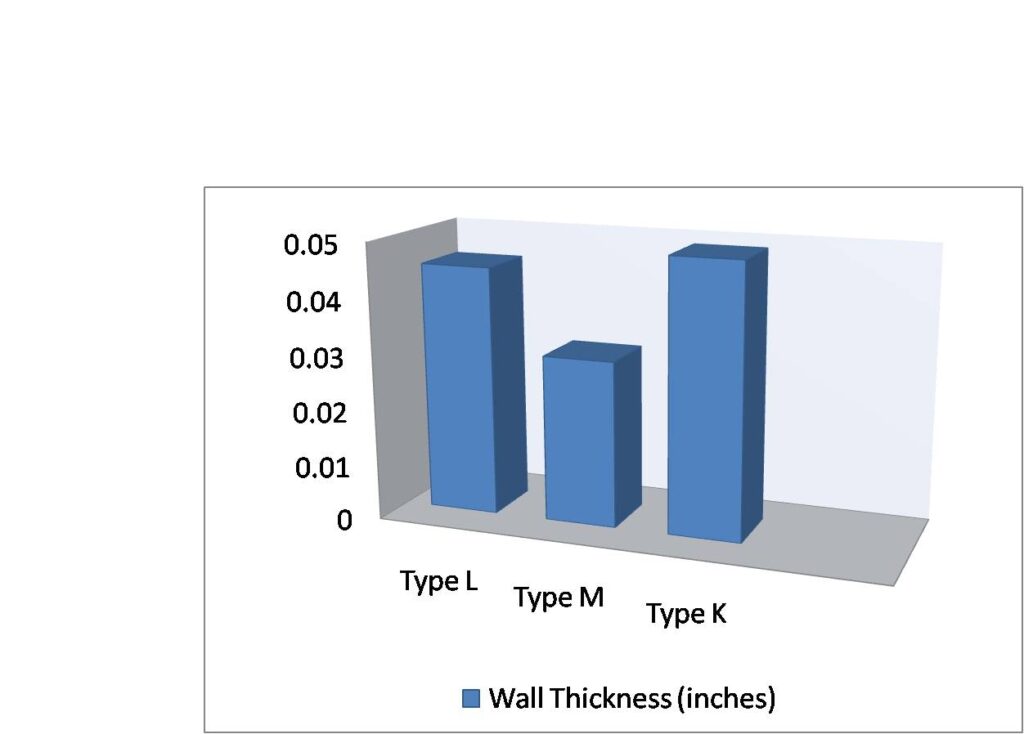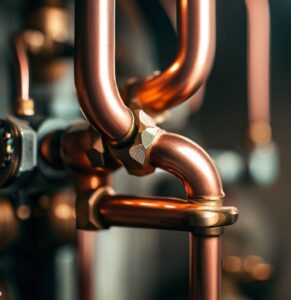Table of Contents
Time to get crafty with copper pipes for a hot water heater! You’ll need to determine the size of the pipe that’s best for you – 1/2 inch and 3/4 inch diameters are the most common.
There are 3 main types of copper pipes: type M, type L, and type K.
- M pipes have thin walls and are used in low to moderate pressure systems.
- L pipes are thicker and handle higher pressures.
- And the thickest walls? That’s type K – often found in commercial settings with high water pressure.

Compression fittings are recommended for connecting copper pipes, as they provide a strong hold that can handle high temperatures. Always consult with a professional plumber or check your local building codes before any DIY plumbing project, for safety regulations.
With these tips in mind, you can confidently design or repair your hot water heating system. Let the copper pipes get steamy!
Key Takeaways
- Use the appropriate tools and materials: To connect a copper pipe to a water heater, you will need a pipe cutter, emery cloth, flux, solder, and a propane torch. Make sure you have all the necessary tools and materials before starting the process.
- Measure and cut the copper pipe: Measure the length of the pipe needed to connect the water heater and use a pipe cutter to cut it to the correct size. Ensure that the pipe is clean and free from any burrs or rough edges.
- Prepare the pipe and fittings: Use emery cloth to clean the ends of the copper pipe and the fittings that will be connected to it. This will help create a clean surface for soldering and ensure a secure connection.
- Apply flux to the pipe and fittings: Apply a thin layer of flux to the cleaned ends of the pipe and fittings. Flux helps to remove any oxidation and allows the solder to flow smoothly during the soldering process.
- Assemble the pipe and fittings: Slide the fittings onto the pipe and ensure they are properly aligned. Make sure the pipe is fully inserted into the fittings to ensure a tight connection.
- Heat the joint and apply solder: Use a propane torch to heat the joint where the pipe and fittings meet. Once the joint is heated, touch the solder to the joint and allow it to flow into the connection. Ensure that the solder completely surrounds the joint for a secure bond.
- Clean and inspect the connection: After soldering, use a damp cloth to clean off any excess flux or solder residue. Inspect the connection to ensure there are no leaks or gaps in the solder joint.
- Test for leaks: Once the connection has cooled down, turn on the water supply and check for any leaks. If there are any leaks, you may need to reheat the joint and apply additional solder to create a watertight seal.
- Follow safety precautions: When working with a propane torch and soldering, it is important to follow safety precautions. Wear protective gloves and goggles, work in a well ventilated area, and keep a fire extinguisher nearby in case of any accidents.
- Seek professional help if needed: If you are unsure about connecting the copper pipe to a water heater or encounter any difficulties during the process, it is recommended to seek professional help. A licensed plumber can ensure a proper and secure connection, minimizing the risk of leaks or other issues.
Understanding Copper Pipes for Water Heaters
Copper pipes are the go-to for water heaters. They have great durability and can handle high temperatures. Different types are available, such as type L, M, and K. It’s important to choose the right size and type for your water heater. Have a look at this table summarizing the key characteristics:
| Type of Copper Pipe | Wall Thickness (inches) | Application |
|---|---|---|
| Type L | 0.045 | Interior Water Supply Lines |
| Type M | 0.030 | Branch Water Lines |
| Type K | 0.049 | Main Water Lines |

Other factors to consider when choosing a copper pipe for your water heater include pressure rating and compatibility with other plumbing systems. Type L is the most common, due to its thickness and affordability. Make sure to check building codes and regulations in your area too.
In conclusion, understanding the different types and sizes of copper pipes is essential. Choose the right one based on thickness and application requirements. Improper choice or installation of copper pipes can lead to leakages and costly repairs in residential water heating systems. Seek professional advice or follow local plumbing codes for accurate guidance.
Connecting Copper Pipes to a Water Heater
Connecting copper pipes to a water heater is an essential part of having a reliable and efficient plumbing system. To help you out, here are four easy steps:
- Pick the right type of copper pipe: Consider the type and size of the copper pipe you’ll need for your hot water heater. Type L and Type M pipes are popular for hot water systems, as they can handle higher pressure and are more durable. Type L has thicker walls, while Type M‘s walls are thinner.
- Measure and cut the pipe: Measure and cut the length of pipe needed for the water heater. You’ll need two pieces – one for the inlet and the other for the outlet. Use a tubing cutter or hacksaw to make the cut.
- Clean and prepare the ends: Make sure to clean and deburr both ends of the pipe with sandpaper or a wire brush. This will help create a secure, leak-free connection.
- Connect the pipes with compression fittings: To attach the copper pipes to the water heater, use compression fittings made for copper piping systems. Slide a compression nut onto each end of the pipe, followed by a compression sleeve. Insert one end into the corresponding inlet or outlet valve on the water heater. Finally, tighten each compression nut with pliers.

Don’t take chances with plumbing – get help from professionals! We offer accurate installation services that comply with local building codes and guarantee excellent performance. Get in touch with us for free quotes today! Need help? We can also troubleshoot common issues and leaks.
Common Water Heater Issues and Troubleshooting
Troubleshooting common problems with connecting copper pipes to a water heater? Look no further! Here’s a table of solutions and tips to help you out:
| Common Issue | Solution |
|---|---|
| Leak in copper pipe | Check connections and fittings. Tighten or replace if needed. |
| Inadequate water pressure | Ensure main valve is open. Also, check for clogs or sediment and clean pipes if needed. |
| Corrosion of copper pipe | Use dielectric unions to prevent contact between different metals. |
| Insufficient hot water supply | Check thermostat and adjust as needed. Also, flush out mineral deposits in the water heater tank. |
When installing copper pipes, use Type L or Type M copper pipes as they have better durability and pressure rating. Secure them with compression fittings to avoid leaks.
Follow these steps and unique details for your water heating system and you’ll have optimal performance with no hassle. Hot water won’t become a hot mess!
Maintenance and Care Tips for Copper Pipes in Water Heating Systems
Maintain your copper pipes for peak performance! Regular inspections, proper insulation, avoiding extreme heat, monitoring water pressure and preventing hard water damage are all key. Copper is a reliable material for plumbing, but may still need maintenance and repairs. Follow local building codes to stay compliant. Remember: centuries of copper pipes have proven their worth! Wrap connections carefully for optimal efficiency.
Frequently Asked Questions
1. What type of copper pipe should I use for a hot water heater?
For hot water heater installations, it is recommended to use Type L copper pipe. Type L pipe has thicker walls compared to Type M, making it more suitable for high-pressure applications.
2. What size copper pipe is ideal for a hot water heater?
The size of copper pipe for a hot water heater depends on the water demand and pressure rating. Generally, a 3/4 inch diameter pipe is suitable for most residential hot water heating systems.
3. Can I use plastic pipes instead of copper pipes for water heater connections?
While plastic pipes like PEX are gaining popularity, copper pipes are still commonly used in water heater installations due to their durability and resistance to high temperatures. Consult local building codes and plumbing professionals to determine the best option for your specific situation.
4. What are compression fittings and when should I use them with copper pipe?
Compression fittings are a type of plumbing connection that uses a nut and ferrule to compress the pipe onto a fitting. They are commonly used with copper pipe for easy and secure connections, especially in areas where soldering may be difficult or prohibited.
5. Are there different types of copper pipe for specific water supply applications?
Yes, there are various types of copper pipes, such as Type L, Type M, and Type K. These types have different wall thicknesses, making them suitable for different water supply systems. Type L is commonly used for hot water heaters, while Type K is recommended for underground water lines and high-pressure systems.
6. Do I need professional plumbers for connecting copper pipe to a water heater?
While it is possible to perform the connection yourself, it is recommended to hire professional plumbers for proper installation and to ensure compliance with plumbing codes. This will help avoid potential leaks, damage, and ensure the longevity of your water heater system.
Conclusion
Connecting copper pipes to water heaters is common. Type L and M pipes are the most popular. Type L pipes are better for high-pressure, while Type M is better for low-pressure.
The size of the pipe depends on water pressure and flow. 3/4-inch diameter is usually used for residential hot water heaters, but this can change.
Building codes and regulations must be followed. Professional plumbers provide expert guidance to ensure safety.
In conclusion, copper pipes come in different types and sizes for water heaters. The type and size should suit your needs. Building codes and regulations must be followed. Professional plumbers can help.
References:
Solder the copper pipe of the hot water heater
Copper Connectors directly to Water Heater Question
